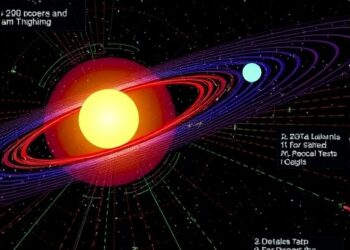Neutron stars, the remnants of massive stars that have undergone supernova explosions, are among the densest known objects in the universe. Their gravitational pull is so immense that a mere handful of neutron star matter—often just a teaspoon—would weigh more than a mountain on Earth. These celestial bodies are not only intriguing due to their extreme densities but also because they hold the key to understanding fundamental physics, particularly the behavior of matter under extreme conditions. The study of neutron stars has become increasingly significant following groundbreaking astronomical events, such as the merger of two neutron stars observed in 2017.
The collision of neutron stars is a phenomenon that has been the focus of intense observation and research. This event not only produces gravitational waves—ripples in spacetime that were first detected by LIGO in 2015—but also offers unique insights into the behavior of matter at unprecedented density levels. When two neutron stars spiral inward and eventually merge, they create a post-merger remnant, a new astronomical object that is an incredibly dense, rapidly rotating core. This remnant radiates gravitational waves in a narrow frequency range that is characterized by a unique pattern—a phenomenon researchers are beginning to understand deeply.
Recently, a group of researchers led by Professor Luciano Rezzolla at Goethe University Frankfurt has made significant strides in analyzing the gravitational waves emitted during the post-merger phase of neutron stars. Their findings introduce a concept termed the “long ringdown,” which describes an interesting phase that follows the initial, intense burst of gravitational waves. During this long ringdown, while the amplitude of the emitted gravitational waves gradually weakens, the frequency becomes more pure and consistent. This change is akin to a large tuning fork after it has been struck—the vibrations settle into a singular, harmonious tone.
The significance of the long ringdown lies in its potential to reveal critical information about the equation of state of nuclear matter, a framework that describes how matter behaves under extreme pressures and densities encountered inside neutron stars. Each unique equation of state corresponds to a different characteristic frequency of ringing in the post-merger remnant. The researchers suggest that by detecting and analyzing these frequencies, scientists could unlock some of the long-standing mysteries surrounding the makeup of neutron stars and the fundamental forces that govern the universe.
The research was fortified through advanced general-relativistic simulations, where the characteristics of neutron star mergers were meticulously modeled. The ability to predict the long ringdown signal depends heavily on the formulations of the equations of state that describe nuclear interactions. By honing in on a select number of these equations, the researchers were able to effectively simulate a broader range of possible models, which not only expedited the computational process but also enhanced the reliability of their findings. They emphasized the importance of these simulations as they can drastically reduce uncertainties concerning the state of matter in neutron stars, especially at the extreme densities encountered within their cores.
According to Dr. Christian Ecker, the lead author of the study, these advancements point to an exciting future in neutron star research. The methodology they’ve established provides crucial constraints that previously did not exist, particularly where observational data is lacking. As new mergers are detected, the long ringdown signal could serve as a pivotal resource for scientists striving to dissect the complexities of neutron star interiors. The research team’s assertion is that this new phase of understanding will enhance future explorations, particularly as gravitational-wave observatories gear up for upcoming detections.
The anticipation surrounding next-generation gravitational-wave detectors, such as the Einstein Telescope, adds another layer of excitement to their findings. Expected to be operational in Europe within the next decade, this advanced technology aims to amplify the sensitivity and frequency range of gravitational wave detections, potentially allowing researchers to capture faint signals from post-merger neutron star events. The successful detection of the long ringdown phase could revolutionize our comprehension of neutron stars and the fundamental physics of matter.
With the promise of new observational opportunities looming, the research by Rezzolla’s group indicates a major leap forward in our quest to comprehend one of the universe’s most enigmatic objects. As scientists continue to unravel the properties of neutron stars, there is hope that the intersection of theoretical modeling and observational astronomy might soon provide answers to lingering questions about the nature of matter at its extremes.
Ultimately, the research not only highlights the collaborative efforts within the scientific community but also emphasizes the depth of study being conducted in the field of astrophysics, particularly in the context of neutron stars. As we advance further into the era of gravitational-wave astronomy, it is evident that each detection holds the potential to deepen our understanding of the cosmos and the fundamental principles that govern it. The journey to definitively characterizing the interiors of neutron stars may still have mountains to climb, but the pathway illuminated by the long ringdown offers remarkable prospects.
In summary, the groundbreaking study from Goethe University Frankfurt provides a glimpse into the future of neutron star research, one rich with possibilities. The long ringdown phase stands to offer unprecedented insights into the fundamental nature of matter, illustrating the exciting synergy between observation and theory in our quest to understand the universe.
Subject of Research: Not applicable
Article Title: Constraining the equation of state in neutron-star cores via the long-ringdown signal
News Publication Date: 3-Feb-2025
Web References: Not provided
References: Not provided
Image Credits: Not provided
Keywords
Gravitational Waves, Neutron Stars, Long Ringdown, Equation of State, Cosmic Events, Astrophysics.




